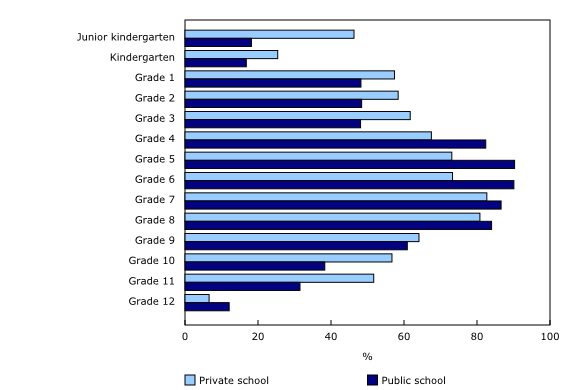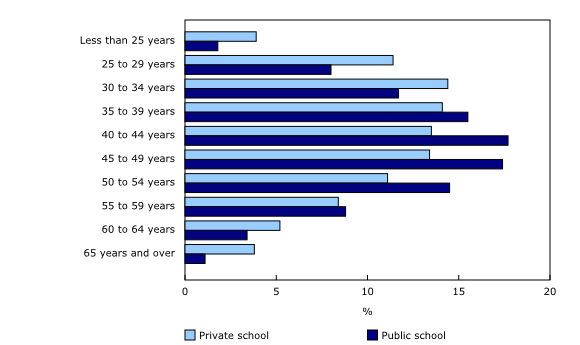Elementary–Secondary Education Survey, 2020/2021
Released: 2022-10-13
At the onset of the COVID-19 pandemic, public health measures introduced to reduce the spread of the virus led to the physical closure of many educational institutions, including elementary and secondary schools. As a result, students and educators experienced changes in the way courses were delivered as shifts were made to online learning methods.
Results from the 2020/2021 Elementary-Secondary Education Survey (ESES), released today, shed light on the potential effects of the COVID-19 pandemic on enrolments, graduates, and educators in elementary and secondary schools.
Data for this release reflect the number of students and educators in the elementary and secondary system from the beginning to the end of the 2020/2021 school year, the first full year affected by the pandemic.
Home-school enrollment doubles in Canada
As school attendance is a legal requirement, variations in enrolments tend to reflect fluctuations in the school-aged population. According to Statistics Canada Population Estimates, the population between 4 and 17 years of age was around 5.7 million in July 2020, up 0.9% from a year ago.
At the same time, there were over 5.6 million students enrolled in Canadian elementary and secondary education programs in 2020/2021, representing a decrease of 0.7% from the previous school year. The decline is more pronounced at the junior kindergarten and kindergarten levels and it was likely a result of some parents delaying their children's start of school at the beginning of the pandemic.
Similar to other years, the vast majority (91.1%) of elementary-secondary students attended public schools in 2020/2021, while private/independent schools (7.5%) and home-schooling (1.5%) represented a lower proportion of enrolments.
While home-schooling remained the least used form of schooling, its use during the pandemic increased substantially, particularly among younger grades. In Canada, there were 83,784 students enrolled in home-school in 2020/2021 compared with 40,608 in the previous academic year, representing an increase of 106.3%. While an increase was observed in almost every grade, it was more pronounced in elementary schools with grade 1 (136.2%) and grade 2 (134.5%) showing the largest increases.
With a move to remote learning, children in younger grades may have had more challenges following a curriculum delivered online. According to the Labour Force Survey, teleworking parents, particularly mothers, were concerned about childcare and return to work. In July 2020, more than one-third (35.6%) of parents with children under 18 years old were concerned that returning to their usual work location would involve challenges related to childcare or caregiving. This share was highest among mothers with at least one child under the age of six (56.1%).
The implementation of public health measures, including school closures, varied by province and likely had an impact on enrolments, as well as the type of schooling among provinces. From 2019/2020 to 2020/2021, ESES data show that public school enrolments decreased across all provinces except for Quebec (+0.9%). As for the territories, public school enrolments decreased in the Northwest Territories and increased in Nunavut (+1.8%) and Yukon (+1.5%). Looking at private school enrolment, the provinces were split, with half seeing an increase, led by New Brunswick (+20.3%) and Prince Edward Island (+17.7%), and the other half observing a decrease in enrolments.
A decline in enrolments was also seen among Indigenous students. In 2020/2021, there were 259,323 Indigenous students in regular programs for youth in public elementary and secondary schools, down 2.0% from the previous school year. Looking at enrolment among students who reported an Indigenous identity, over two-thirds (69.0%) were First Nations, another 27.5% were Métis and 3.5% were Inuit.
To further explore data on enrolments in a visual format across different geographies and academic years, visit the new visualization tool "Elementary to Postsecondary Student Education Dashboard: Enrolments, Graduations and Tuition Fees."
Grades 4 to 8 have the highest enrolment rates in second official languages programs
While ESES cannot be used to study students' pathways in second official language programs over time, looking at enrolments by grade can provide an indication of the level at which students enroll in these programs. Second official language programs include regular second language programs (or core language programs), French immersion programs, and education programs in the minority official language.
Using 2006 and 2016 Census data, a recent publication on bilingualism among Canadian children and youth shows that English-French bilingualism is increasing among children and youth aged 5 to 17 years old. The same publication also found that among Canadian youth, English-French bilingualism tends to increase as they get older.
In 2020/2021, ESES data show enrolments in second official language programs tend to peak between grade 4 and grade 8.
Some differences are observed when looking at school type. In the private schools, grade 7 had the highest proportion (82.7%) of students enrolled in one of the second official language programs. Meanwhile, in public schools, grades 5 and 6 accounted for the highest proportions.
Slight increase in graduates
In 2020/2021, 386,730 students graduated from Canadian high schools, up slightly (+0.5%) compared with 2019/2020. Of these, 89.4% graduated from public schools, while 10.6% graduated from private/independent schools. Graduates from home-schooled programs are included in either the public or the private/independent graduate counts.
Educators tend to be younger in private schools
In 2020/2021, there were 437,691 educators in Canadian elementary and secondary schools, up 1.6% from the previous school year. The increase was mainly driven by an increase in public school educators (+1.7%), while at the same time there was a slight decrease in educators in private schools (-0.5%).
While the proportions of male and female educators were equally distributed in private and public schools, educators tended to be younger in the private schools. The proportion of educators under the age of 35 in private schools (29.7%) was higher than in the public system (21.6%).
Note to readers
The data in this release are from the Elementary–Secondary Education Survey (ESES). The ESES is an annual survey that collects aggregate data from each provincial/territorial ministry or department of education. The 2020/2021 ESES, conducted in 2022, collected data for five school years: 2016/2017 to 2020/2021.
The enrolment counts represent data for programs in Canada's public and private/independent elementary and secondary schools, as well as for home-schooled students, as provided by the provinces and territories. The number of students represents those enrolled in elementary–secondary programs at the beginning of the school year (in September or as close as possible thereafter).
The increase in the student-aged population is based on population estimates in table 17-10-0005-01.
The graduate counts represent first-time graduates from secondary schools (both public and private/independent). Graduates from home-schooled programs are distributed between the public or the private/independent graduate counts. In 2020/2021, nine provinces reported high school graduates from private/independent schools.
The territories do not have any private/independent schools.
Public schools are publicly funded elementary and secondary schools that are operated by school boards or the province or territory.
Private/independent schools encompass elementary and secondary schools that are operated, managed and administered by private individuals and/or groups (for example, a church, a trade union or a business enterprise, or a foreign or international agency) or that have a governing board that exercises powers similar to those of a board of education and consists mostly of members not selected by a public agency. The schools included in the private/independent school sector vary across jurisdictions. For example, in Manitoba, Catholic schools are included in this sector, while in other provinces and territories they are not.
The extent to which an institution receives funding from public or private sources does not determine its classification as a public or private/independent school for the ESES. Privately managed schools may be subject to some regulation or control by public authorities, but these institutions are nevertheless classified as private/independent, provided that they are ultimately subject to private control. Public regulation may extend to areas such as curriculum, staffing appointments, admissions policies, and other matters. The ESES does not distinguish between government-dependent private and independent private institutions.
Home-schooling is an alternative method of learning that takes place outside the public or private/independent school environment. Parents choosing home-schooling have the primary responsibility of managing, delivering and supervising their children's courses and programs of learning. Although home-schooling students may be associated with a public or private/independent school, the enrolment counts for home-schooling are reported separately.
Any detailed comparisons between the provinces and territories must be undertaken with caution. Reporting by type of school varies across jurisdictions. For example, Manitoba includes its students in Catholic schools under "private/independent schools," and Nunavut includes its counts for students in home-schooling (typically less than 10) under "public schools." Reporting by program type also varies across jurisdictions. While all provinces and territories report students in regular programs for youth, a few also report students in general programs for adults and/or vocational programs.
All numbers, including the totals, have been randomly rounded; therefore, sums of the values for the provinces and territories may not add up to the total counts for Canada. Calculations were done using unrounded values. All data are subject to revision.
Products
To further explore 2020/2021 elementary to secondary enrolment and graduation data in a visual format, refer to the comprehensive data visualization tool "Elementary to Postsecondary Student Education Dashboard: Enrolments, Graduations and Tuition Fees."
This new comprehensive data visualization tool combines information from three surveys: Tuition and Living Accommodation Costs, Elementary-Secondary Education Survey, and the Postsecondary Student Information System. Each survey is released separately, and information includes the cost of tuition, an overview of total enrolment and graduation counts, characteristics of students and programs, and details on new enrolments by gender, age group and student status.
Contact information
For more information, or to enquire about the concepts, methods or data quality of this release, contact us (toll-free 1-800-263-1136; 514-283-8300; infostats@statcan.gc.ca) or Media Relations (statcan.mediahotline-ligneinfomedias.statcan@statcan.gc.ca).
- Date modified:




